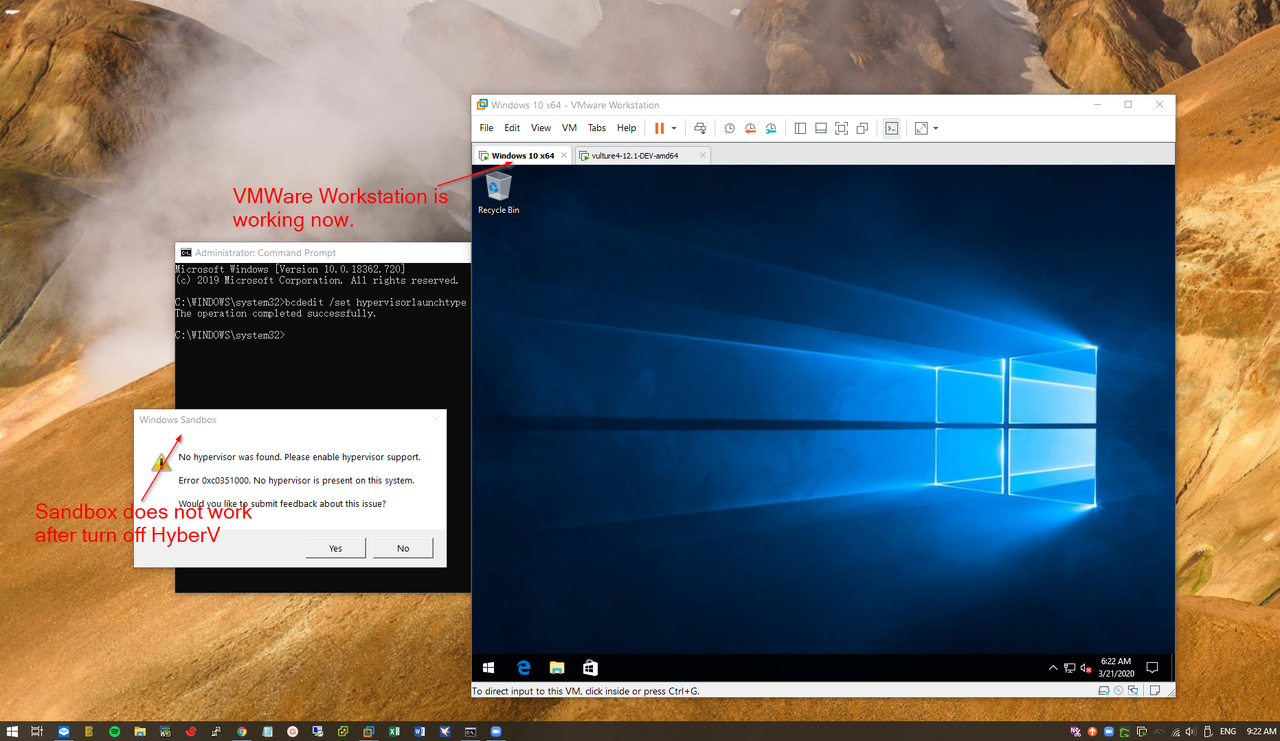Credential Guard Incompatible Issue
Just recently after upgrading Windows 10 1903, I found there is an incompatibility issue between VMware Workstation and Device / Credential Guard.


Note: New Version Solution(VMware Workstation 15.5 Now Supports Host Hyper-V Mode): To run Workstation/Player using the Windows Hypervisor APIs, the minimum required Windows 10 version is Windows 10 20H1 build 19041.264. VMware Workstation/Player minimum version is 15.5.5.
VMware Workstation and Windows 10 systems will inevitably have some problems, especially after each major upgrade of Windows 10. This is particularly obvious. The issue of incompatibility between VMware Workstation and Device / Credential Guard has been reported before. In order to experience the Sandbox Sandbox upgrade of Windows 10 for the first time, I did not expect to encounter a device / Credential Guard incompatibility issue.
I have seen compatibility issues between VMware Workstation and Hyper-V in a previous article on Windows 8, which mainly explains that the Hyper-V role conflicts with VMware Workstation, and it really looks like this on Windows 10. Although I found a lot of articles about modifying the registration area, I found that it is most convenient and straightforward to use the command line to turn off the Hyper-V role function.
"Command Prompt" is a shell program used to run a console program or some DOS under Windows. To open the "Command Prompt" window is very simple, but to open the "Command Prompt" with administrator rights.
Although there is a knowledge base article on VMware on how to disable Windows Defender Credential Guard, it is still inconvenient. I still find it most convenient to use the command line to disable Hyper-V role. To disable the Hyper-V role feature, use the "bcdedit /set hypervisorlaunchtype off" command.
C:\WINDOWS\system32>bcdedit /set hypervisorlaunchtype off
The operation completed successfully.
C:\WINDOWS\system32>
After the input is successful, remember to reboot and execute the VM virtual machine on VMware Workstation again. Sure enough, there is no incompatibility between Device / Credential Guard.
To enable the Hyper-V role, please use the "bcdedit / set hypervisorlaunchtype auto" command, remember to restart the same after completion.
C:\WINDOWS\system32>bcdedit /set hypervisorlaunchtype auto
The operation completed successfully.
C:\WINDOWS\system32>
This Host Does Not Support VT-X and Intel EPT Issue
Windows Hypervisor Platform solution will not always work for some CPUs. Here is one issue I met on my HP Z600 Workstation which is using Intel Xeon X5660 @ 2.80GHz CPU.
I did an upgrade my Windows 10 to version 2004 and VMWare Workstation Upgrade to 15.5.6. Now I am getting this error on my HP Z600 Workstation. VT-X and Intel EPT are enabled on BIOS and supported by my CPU.
Failed to Connect Pipe to Virtual Machine Issue
Moved one of my VMs from one machine to another. Now, when try to turn on, I got this "Failed to connect piple to virtual machine: The system cannot find the file specified." issue.Fix 1: Repairing the Microsoft Visual C++ 2015 Redistributables from Add/Reomve Programs.
Fix 2: Download and install Visual Studio 2015, 2017, 2019, and 2022
- Download Page: https://learn.microsoft.com/en-US/cpp/windows/latest-supported-vc-redist?view=msvc-170
- Download Link for x64: https://aka.ms/vs/17/release/vc_redist.x64.exe
After installation, the issue is gone, without even a reboot.
There are no un-bridged host network adapters
Workstation fails to bridge adapter with the error: Cannot change network to bridged: There are no un-bridged host network adapters (2005168)
Fix:
- » Control Panel
- » Network and Internet
- » Network and Sharing Center
- » “Change adapter settings”
now Choose one of the physical network adapter,
right-click on it then click Properties. - If the VMware Bridge Protocol is present and unchecked, check it and click ok, and that should fix this error
- but if it’s not there at all, we have to add it to do that
- click on install then select service and click add
- on the manufacturer bar choose VMware, Inc.
- on Network service choose VMware Bridge Protocol just like shown on the photo below
Force a Frozen VM to Power Off
- Click Start > Run, type taskmgr, and click OK. The Task Manager window opens.
- Click the Processes tab.
- Locate the vmware-vmx.exe process.
- Click the vmware-vmx.exe process and click End Process. This stops the virtual machine process and forces it to power off.
- Start the VMware Workstation GUI and confirm.
















No comments:
Post a Comment